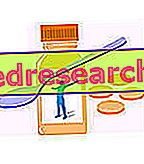Generality
The term euthyroidism refers to a condition in which the levels of thyroid hormones are normal .

The condition of euthyroidism subsists when the thyroid is functioning properly producing adequate amounts of hormones; or when the gland in question does not function properly, but the normal physiological levels of thyroid hormones are reached and maintained by pharmacological treatments or surgery.
During this article, therefore, we will analyze the therapeutic strategies implemented to guarantee the maintenance of the condition of euthyroidism in patients suffering from various types of thyroid diseases and dysfunctions.
What is that
What is Euthyroidism?
Euthyroidism is a condition in which thyroid hormones - triiodothyronine or T3 and thyroxine or T4 - are present in normal and physiological concentrations (for more detailed information on thyroid values, see the dedicated article: Thyroid Blood Tests).
More in detail, it is possible to speak of euthyroidism when:
- The thyroid functions properly and synthesizes hormones in the right quantities;
- The thyroid is not functioning properly and, on its own, it is not able to maintain normal concentrations of thyroid hormones, but the latter are guaranteed by different types of treatments (pharmacological, surgical, etc.) which vary according to the type of disease or disorder afflicting the gland in question.
Did you know that ...
When euthyroidism conditions are restored in a patient through appropriate treatments, this is referred to as " euthyroid ".
The condition of euthyroidism can be altered both due to a reduced synthesis of thyroid hormones ( hypothyroidism ), and to an excessive production of the same ( hyperthyroidism ).
The therapeutic strategies implemented to restore the conditions of euthyroidism, therefore, are different and will aim to increase the amount of circulating thyroid hormones in the presence of hypothyroidism; while aiming to reduce their levels in the presence of hyperthyroidism.
Hypothyroidism
Restoration of Euthyroidism in Patients with Hypothyroidism
Hypothyroidism is a pathological condition characterized by reduced secretion of thyroid hormones by the thyroid gland. In such a condition, therefore, the levels of circulating hormones T3 and T4 are not sufficient to guarantee the performance of normal activities.
Depending on the underlying cause, hypothyroidism is divided into:
- Primitive : is a type of hypothyroidism that results from a specific malfunction of the thyroid gland . The main causes triggering the primitive form of hypothyroidism are:
- Autoimmune thyroid disorders (the most famous of which is, without a shadow of a doubt, Hashimoto's thyroiditis);
- Thyroidectomy (partial or total removal of the thyroid gland, for example, in the presence of thyroid tumors);
- Iodine deficiency, an essential element for the synthesis of hormones T3 and T4.
- Secondary : it is a form of hypothyroidism that becomes unsaturated due to a pituitary malfunction . The causes of such a malfunction may lie in tumors or pituitary lesions.
Deepening: Pituitary, Hypophyseal Hormones and Euthyroidism
The pituitary gland is a fundamental gland in the functioning of the thyroid, since it is able to control its activity through the secretion of the thyroid stimulating hormone (also known as thyrotropin, thyroid-stimulating hormone or with the acronym TSH, from the English Thyroid Stimulating Hormone ). The TSH, in fact, is able to promote the absorption of iodine and stimulates the thyroid to release the hormones T3 and T4 in the bloodstream. Therefore, also the pituitary and TSH are involved in maintaining the condition of euthyroidism.
- Tertiary : tertiary hypothyroidism is induced by a malfunction of the hypothalamus which can be caused by the presence of neoplastic pathologies or lesions located, precisely, at the hypothalamic level.
Deepening: Hypothalamus, TRH and Euthyroidism
Similarly to what has been said for the pituitary gland, the hypothalamus is also involved - indirectly - in the regulation of thyroid activity and in maintaining the condition of euthyroidism. In fact, the hypothalamus secretes TRH ( Thyrotropin Releasing Hormone, ie the thyrotropin-releasing hormone ) which acts on the pituitary gland, stimulating it to secrete and release the TSH mentioned above.
- Iatrogenic : it is a type of hypothyroidism triggered by medical treatment and pharmacological treatments . A classic example of iatrogenic hypothyroidism is that generated by the administration of drugs to treat hyperthyroidism in excessively high dosages.
Did you know that ...
Some patients may suffer from subclinical hypothyroidism, a particular condition characterized by the presence of elevated TSH levels and levels of thyroid hormones T3 and T4 in the standard. In this case, therefore, despite the presence of altered thyrotropin levels, there is a condition of euthyroidism.
Hypothyroidism treatment
The treatment performed to restore the conditions of euthyroidism in hypothyroid patients involves the establishment of a hormone replacement therapy . The drugs currently used to achieve this goal are based on active ingredients such as levothyroxine sodium (Eutirox®) and sodium liothyronine (Liotir®, Titre®). These are synthetic active ingredients administered in order to make up for the deficiency of thyroxine and triiodothyronine, respectively. They can be used both in monotherapy and in combination therapy.
Clearly, the dosage and type of active ingredient to be administered must be established by the endocrinologist.
In cases of hypothyroidism characterized by conditions of euthyroidism, however, the use of hormone replacement therapy is not necessary.
To learn more: Hypothyroidism »Hyperthyroidism
Restoring the condition of Euthyroidism in Patients with Hyperthyroidism
Hyperthyroidism is a disease characterized by excessive activity of the thyroid gland resulting in increased secretion of thyroid hormones .
Hyperthyroidism can be caused by various diseases, disorders, conditions and dysfunctions, such as:
- Graves-Basedow disease;
- Toxic nodular goiter and toxic multinodular goiter;
- Increased production of TSH by the pituitary gland;
- Thyroid adenoma;
- Excessive intake of iodine;
- Abuse of thyroid preparations.
Unlike what happens for hypothyroidism which, as stated above, involves the administration of hormone replacement therapy, the treatment of hyperthyroidism is not as simple. In fact, the therapeutic strategy to be implemented to restore the conditions of euthyroidism in hyperthyroid patients can vary greatly depending on the cause that triggered the problem. The treatments usually used in such situations will be illustrated below.
thyroidectomy
Thyroidectomy is the surgical operation through which the removal - total or partial, depending on the case - of the thyroid gland is performed. The use of this type of surgical treatment may be necessary in the presence of thyroid, goiter or thyroid nodule tumors.
Please note
Total removal of the thyroid makes it necessary to resort to hormone replacement therapy in order to guarantee the presence of thyroid hormones in adequate concentrations.
The partial removal of the gland, on the other hand, does not always require the administration of synthetic thyroid hormones; however, it is also true that it represents one of the causes triggering primitive hypothyroidism. In the presence of a similar event, the patient will therefore have to take levothyroxine sodium and / or liothyronine sodium.
However, for more information on this, we recommend reading the dedicated article: Thyroidectomy.
Radioactive iodine therapy
Radioactive iodine therapy involves the administration in relatively high doses - generally, intravenously - of iodine 131, a radioactive isotope that, once taken, is absorbed by the thyroid gland. The radioactivity possessed by this element is able to damage the thyroid cells that produce excessive amounts of hormones, thus decreasing the functionality of the gland and improving the clinical picture of hyperthyroidism which, slowly, will move towards a condition of euthyroidism. A similar treatment is carried out especially in the presence of thyroid tumors, in some cases, even in preparation for thyroidectomy operations.
Did you know that ...
Radioactive iodine is also used for diagnostic purposes in the context of thyroid disorders characterized by hyperthyroidism.
To learn more, we recommend that you consult the dedicated articles: Iodine 131 - Radioactive Iodine and Thyroid - Radioactive Iodine: Indications and Post-Treatment.
Pharmacological therapy with antithyroid drugs
Drug therapy based on antithyroid drugs can be used in preparation for thyroid removal surgery (thyroidectomy), in preparation for radiolabelled iodine therapy, or as the only treatment in cases where surgery cannot be performed. The active ingredient usually used in such occasions is tiamazole, also known as methimazole (Tapazole®).
Another active ingredient with antithyroid action that is administered in an attempt to restore euthyroid conditions in hyperthyroid patients is represented by potassium perchlorate (Pertiroid®).
However, to learn more about the drugs used to restore euthyroidism in hyperthyroid patients, see also: Drugs for treating Hyperthyroidism.



